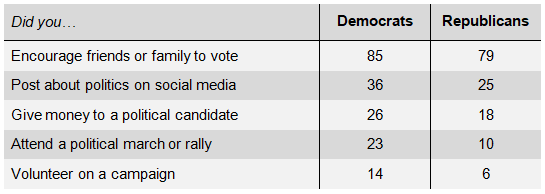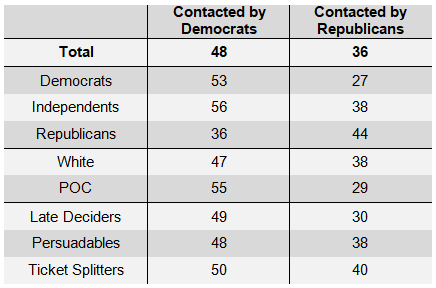Research led by GQR Partner Al Quinlan and Senior Associate Ben Winston.
Read the original press release from DCCC here
Democrats swept into the majority in the House in 2018, winning a net 40 seats and over 53 percent of the vote nationally – the largest ever margin of victory in a midterm election for either party at over 8.8 million votes.
A post-election survey* of 45 Democratic-won swing districts conducted by GQR confirms what we observed in competitive campaigns across the country this year and helps explain the broad scope of the Democratic victories.
The survey makes clear that these 45 wins were not simply attributable to a national environment that favored Democrats – they came in many tough, Republican-leaning seats that Democrats could well have lost based on key predictors.
These Democrats substantially outperformed partisanship and the 2016 presidential margin across the board, and won critical swing groups like independents, voters who decided in the final week, and those who changed their mind during the campaign.
A few dynamics stand out that made this possible:
-
Democrats fielded incredibly strong candidates who fit their districts and brought character and compelling narratives to their races. They cut against what people believe is wrong with Washington and offered a change from what voters see as typical politicians
-
Democratic candidates ran campaigns that told their own compelling stories and developed a sharp and consistent contrast with Republican candidates. The Democratic messages were disciplined, appealed broadly, and voters awarded them for being more positive than their Republican opponents.
-
Democratic candidates and the Democratic Congressional Campaign Committee ran extremely effective field efforts that produced greater engagement in their base, while also persuading the swing blocs of voters in the middle of the electorate. Democrats ultimately built a remarkable winning coalition of a consolidated base, advantages among independents, and significant defections among Republicans.
A Convincing Victory, Despite Voters’ Partisanship
Democrats won these 45 competitive, GOP-leaning districts by an average of six points. The forty-five districts surveyed here represented a tough map for Democrats. On average, these districts went 45-44 percent for Trump in 2016, and lean Republican by voters’ partisan identification. Thirty-five of the districts were held by Republicans in Congress. Yet Democrats won every race, with an average margin of 6 points.
Figure 1: Partisan Breakdown of Sample


Democratic performance was driven by near-unanimous margins in the base but also crucial crossover from Republicans and independents that was necessary to win seats these Republican leaning seats. Ninety-five (95) percent of self-identified Democrats voted for the Democratic candidate in their district, with only 3 percent voting for the Republican. But winning these districts required crossover support as well: Democrats won because of an edge among independent voters (49-42 percent) and a Republican base that was more likely to crossover for Democrats (10-87 percent).
Impressive margins among key demographics. Turnout was high nationally and across these battleground districts relative to previous midterms – but turnout was up across the board, not just among base Democrats. The profile of the electorate alone cannot explain these victories – Democratic candidates outperformed historical margins among a number of important groups:
-
Women. Democrats won by 13 points among women, and by a similar margin among independent women (53-40 percent).
-
Younger voters. Democrats won voters under age 50 by a 21-point margin across this battleground, and by an even larger margin among younger women.
-
College graduates. Democratic candidates were +16 among college graduates, including +13 among white college graduates. Meanwhile, they held down deficits among white non-college voters (41-56 percent).
-
Voters of color. Democrats’ historic investment in African-American, Hispanic, and AAPI voters paid dividends: African-American voters supported the Democratic candidate by an 86-11 percent margin, and Hispanic voters by a 62-32 percent margin.
Democrats won these seats by winning swing voters
-
Late deciders. Democrats outperformed partisanship markedly among the 16 percent of voters who made their decision in the final week. These voters identified as Republicans by a substantial margin (R+16), yet Democrats won this group 48-45 percent.
-
“Persuadables”. Similarly, Democrats did extraordinarily well among the 27 percent of voters who changed their mind (or considered doing so) over the course of the campaign – another sign of the strength of Democratic candidates and campaigns. These ‘persuadables’ leaned Republican in party identification by a 14-point margin, yet ended up voting for the Democrat 52-48 percent.
-
Ticket-splitters. Eleven percent of voters report splitting their votes evenly between the two parties in major elections over the past few years. Trump won them by 12-points in 2016, but they went for Democrats 50-39 percent.
Strong Candidates and Campaigns
The reason why Democrats did so well and outperformed partisanship among key groups is they ran relatively positive campaigns, ran strong candidates and enjoyed a greater level of engagement among base voters than the Republicans.
Positive campaigns worked and Democratic candidates had much stronger standing than their Republican opponents. Negative advertising is critical in competitive races, and the Democrats utilized it effectively in their campaigns. But the impact of Democrats’ positive media compared to Republicans’ lack of positive ads is stunning. Democratic candidates – many of whom challenged entrenched, well-known incumbents – built their profiles with sustained positive paid communication. This strategy contrasted notably with Republicans and their allies, who often ran a larger ratio of negative-to -positive advertisements, and in some cases did not run positive at all.
Voters noticed.
-
The difference in perceptions of the named candidates after a hard-fought election was stark: Democratic candidates emerged with favorability ratings of 49-30 percent favorable-unfavorable (net +19), while ratings for Republicans were 39-36 percent (net +3) – a massive difference. Voters viewed these Democratic candidates independently from “Democrats in Congress” generally, who receive mixed ratings (44-47 percent).
-
By a 3 to 1 ratio, voters recall seeing more positive ads supporting Democratic candidates than Republican candidates. Recall of negative ads is about even.
The quality of Democratic candidates and campaigns drove this victory. Democrats benefited from candidates in battleground districts whose personal profile, background, and character, as well as a focused issue agenda, set them apart from the norm and served as the primary motivator of their winning coalitions. Democratic voters voted more FOR the Democratic candidate (68 percent) than AGAINST the Republican (24 percent).
Open-ended responses suggest two main reasons why:
-
Profiles. This was a remarkably strong class of Democratic candidates – compelling, qualified, diverse, and a fit for the districts they ran in. These candidates looked, felt, and sounded very different than typical politicians – and each fit their specific district and electorate in a clear way. Across the battlefield, Democrats ran a substantial number of veterans or candidates with national security experience, prosecutors, candidates of color, women, younger candidates, and candidates identifying as LGBTQ. Voters believed them when they said they would do things differently and reform Washington as it fit within their narrative.
-
Issues. Democrats centered their campaigns on a focused set of issues and contrasts that matched voters’ top concerns. Democrats spoke to the issues people cared about – led by healthcare and prescription drugs – and stayed disciplined in their messaging.
Candidates in these districts—like voters in these districts–took a nuanced approach to President Trump. Many Democratic candidates won in districts that Trump carried in 2016 thanks to a nuanced approach that captured base Democrats’ passion while appealing to the middle of the electorate. The President was a major motivator for the Democratic base, but the President has nearly a 1:1 approve-disapprove rating across this battleground. Democratic candidates made inroads across the aisle by focusing less on the President and more on addressing voters where they were – with concrete solutions on healthcare, infrastructure, jobs, and other important issues. When asked, they said they’d work with Trump if he was serious about working together on these issues – if not, they’d stand up to him. He was not the focus of most of these swing-district Democratic campaigns.
Democratic voters were engaged and involved with campaigns, often for the first time. Democratic voters reported volunteering, donating, and engaging with campaigns more than Republican voters.
Figure 2: Voter Engagement by Party


And Democratic field operations outperformed Republican efforts, including among swing voters. In all, 48 percent of voters report being contacted by phone, text, or door knock on behalf of the Democratic candidate for Congress in their district – while only 36 percent heard from Republicans. The difference was even greater among independents: 56 percent heard from Democrats, and 38 percent from Republicans. And 55 percent of voters of color were contacted by Democrats, compared to just 29 percent who were contacted by Republicans.
Figure 3: Personal Contact from Campaigns


Conclusion
The traditional out-party bump in mid-term elections and the President’s low approval ratings would have afforded the Democrats a good election cycle regardless. But a gain of 41 seats (with one still disputed) and 8.8 million vote margin was not inevitable in January of this year. The combination of particularly compelling candidates who defined themselves in positive and non-political ways and their disciplined, energized campaigns turned a promising political environment into a wave election.
* These results are based on a telephone survey of 1000 voters across 45 Democrat-won swing districts. The survey was conducted by Greenberg Quinlan Rosner Research on behalf of the DCCC from November 8-14, 2018. The margin of error is +/- 3.1 percent at the 95 percent confidence interval, and higher among subgroups.

